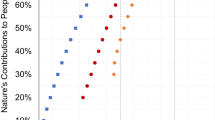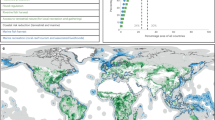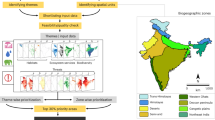Abstract
Increasing human pressures are driving a global loss of biodiversity and of Nature’s Contributions to People (NCP)—the contributions of living nature to people’s quality of life. Understanding the spatial relationship between biodiversity and NCP is essential for securing Earth’s life support systems. Here we estimate the importance of high-biodiversity regions in maintaining the provision of three NCP under four scenarios of climate change. We focus on critical regulatory NCP which are currently facing decline: regulation of air quality, climate and freshwater quantity. We estimate the current and future value of NCP using a suite of environmental indicators and evaluate whether risk from environmental change is higher or lower within high-biodiversity regions compared with control regions. We find higher levels of NCP within high-biodiversity regions both in the present and the future for all indicators, which highlights the spatial congruence between biodiversity and NCP. Moreover, air quality and climate regulation indicators show rapidly increasing levels within high-biodiversity regions, especially under higher-emission scenarios. Our results point to a substantial contribution of high-biodiversity areas to the provision of NCP. Protecting areas of high biodiversity value will synergistically contribute to the preservation of many of nature’s contributions humanity depends on.
This is a preview of subscription content, access via your institution
Access options
Access Nature and 54 other Nature Portfolio journals
Get Nature+, our best-value online-access subscription
$29.99 / 30 days
cancel any time
Subscribe to this journal
Receive 12 digital issues and online access to articles
$119.00 per year
only $9.92 per issue
Buy this article
- Purchase on Springer Link
- Instant access to full article PDF
Prices may be subject to local taxes which are calculated during checkout


Similar content being viewed by others
Data availability
All input data used in these analyses were obtained from published sources cited in Methods. The CMIP6 datasets analysed during the current study are available from https://esgf-node.llnl.gov/search/cmip6/, while WorldClim data are available from https://www.worldclim.org/data/index.html. We retrieved land-use data from the LUH2 dataset33 available at http://luh.umd.edu/data.shtml, while land-cover data were dowloaded from the ESA CCI Land Cover (CCI-LC) project (https://www.esa-landcover-cci.org/). The maps of high-biodiversity regions refer to the map of scientific consensus score from ref. 25 and are available on Zenodo at https://doi.org/10.5281/zenodo.8036779.
Code availability
Codes and datasets used for the analyses are openly available on Zenodo at https://doi.org/10.5281/zenodo.7351590.
References
First Draft of the Post-2020 Global Biodiversity Framework (Convention on Biological Diversity, 2021).
Chaplin-Kramer, R. et al. Mapping the planet’s critical natural assets. Nat. Ecol. Evol. 7, 1–11 (2022).
Jung, M. et al. Areas of global importance for conserving terrestrial biodiversity, carbon and water. Nat. Ecol. Evol. 5, 1499–1509 (2021).
Pereira, H. M. et al. Global trends in biodiversity and ecosystem services from 1900 to 2050. Preprint at bioRxiv https://doi.org/10.1101/2020.04.14.031716 (2020).
Di Marco, M. et al. Synergies and trade-offs in achieving global biodiversity targets. Conserv. Biol. 30, 189–195 (2016).
Loarie, S. R. et al. The velocity of climate change. Nature 462, 1052–1055 (2009).
Ecosystems and Human Well-being: Health Synthesis (WHO, 2005).
Costanza, R. et al. The value of the world’s ecosystem services and natural capital. Nature 387, 253–260 (1997).
Díaz, S. et al. Assessing nature’s contributions to people. Science 359, 270–272 (2018).
Brauman, K. A. et al. Global trends in nature’s contributions to people. Proc. Natl Acad. Sci. USA 117, 32799–32805 (2020).
Díaz, S. et al. (eds) Summary for Policymakers of the Global Assessment Report on Biodiversity and Ecosystem Services (IPBES, 2019).
Balvanera, P. et al. Linking biodiversity and ecosystem services: current uncertainties and the necessary next steps. Bioscience 64, 49–57 (2014).
Hooper, D. U. et al.Effects of biodiversity on ecosystem functioning: a consensus of current knowledge. Ecol. Monogr. 75, 3–35 (2005).
Le Provost, G. et al. The supply of multiple ecosystem services requires biodiversity across spatial scales. Nat. Ecol. Evol. https://doi.org/10.1038/s41559-022-01918-5 (2022).
Cardinale, B. J. et al. Biodiversity loss and its impact on humanity. Nature 486, 59–67 (2012).
Balvanera, P. et al. Quantifying the evidence for biodiversity effects on ecosystem functioning and services. Ecol. Lett. 9, 1146–1156 (2006).
Cardinale, B. J. et al. The functional role of producer diversity in ecosystems. Am. J. Bot. 98, 572–592 (2011).
Scheffers, B. R. et al. The broad footprint of climate change from genes to biomes to people. Science 354, aaf7671 (2016).
Di Marco, M. et al. Projecting impacts of global climate and land-use scenarios on plant biodiversity using compositional-turnover modelling. Glob. Change Biol. 25, 2763–2778 (2019).
Newbold, T. Future effects of climate and land-use change on terrestrial vertebrate community diversity under different scenarios. Proc. R. Soc. B 285, 20180792 (2018).
Chaplin-Kramer, R. et al. Global modeling of nature’s contributions to people. Science 366, 255–258 (2019).
O’Connor, L. M. J. et al. Balancing conservation priorities for nature and for people in Europe. Science 372, 856–860 (2021).
Soto-Navarro, C. et al. Mapping co-benefits for carbon storage and biodiversity to inform conservation policy and action. Phil. Trans. R. Soc. B. 375, 20190128 (2020).
Smith, A. C. et al. How natural capital delivers ecosystem services: a typology derived from a systematic review. Ecosyst. Serv. 26, 111–126 (2017).
Cimatti, M., Brooks, T. M. & Di Marco, M. Identifying science-policy consensus regions of high biodiversity value and institutional recognition. Glob. Ecol. Conserv. 32, e01938 (2021).
O’Neill, B. C. et al. The roads ahead: narratives for shared socioeconomic pathways describing world futures in the 21st century. Glob. Environ. Change 42, 169–180 (2017).
Zhu, Z. et al. Global data sets of vegetation leaf area index (LAI)3g and fraction of photosynthetically active radiation (FPAR)3g derived from global inventory modeling and mapping studies (GIMMS) normalized difference vegetation index (NDVI3g) for the period 1981 to 2011. Remote Sens. 5, 927–948 (2013).
Isbell, F. et al. Linking the influence and dependence of people on biodiversity across scales. Nature 546, 65–72 (2017).
Chaplin-Kramer, R. et al. Mapping the planet’s critical natural assets. Nat. Ecol. Evol. 7, 51–61 (2023).
Friend, A. D. et al. Carbon residence time dominates uncertainty in terrestrial vegetation responses to future climate and atmospheric CO2. Proc. Natl Acad. Sci. USA 111, 3280–3285 (2014).
Pugh, T. A. M. et al. Understanding the uncertainty in global forest carbon turnover. Biogeosciences 17, 3961–3989 (2020).
Shao, P., Zeng, X., Sakaguchi, K., Monson, R. K. & Zeng, X. Terrestrial carbon cycle: climate relations in eight CMIP5 Earth system models. J. Clim. 26, 8744–8764 (2013).
Hurtt, G. et al. Harmonization of global land-use change and management for the period 850–2100 (LUH2) for CMIP6. Geosci. Model Dev. https://doi.org/10.5194/gmd-2019-360 (2020).
Runde, I., Zobel, Z. & Schwalm, C. Human and natural resource exposure to extreme drought at 1.0 °C–4.0 °C warming levels. Environ. Res. Lett. 17, 064005 (2022).
Feng, X. et al. How deregulation, drought and increasing fire impact Amazonian biodiversity. Nature 597, 516–521 (2021).
Keys, P. W., Wang-Erlandsson, L. & Gordon, L. J. Revealing invisible water: moisture recycling as an ecosystem service. PLoS ONE 11, e0151993 (2016).
Di Marco, M., Watson, J. E. M., Currie, D. J., Possingham, H. P. & Venter, O. The extent and predictability of the biodiversity–carbon correlation. Ecol. Lett. 21, 365–375 (2018).
Isbell, F. et al. Biodiversity increases the resistance of ecosystem productivity to climate extremes. Nature 526, 574–577 (2015).
Gonzalez, A. et al. Scaling-up biodiversity–ecosystem functioning research. Ecol. Lett. 23, 757–776 (2020).
Ricketts, T. H. et al. Disaggregating the evidence linking biodiversity and ecosystem services. Nat. Commun. 7, 13106 (2016).
Turner, W. R. et al. Global conservation of biodiversity and ecosystem services. Bioscience 57, 868–873 (2007).
Song, X., Wang, D. Y., Li, F. & Zeng, X. D. Evaluating the performance of CMIP6 Earth system models in simulating global vegetation structure and distribution. Adv. Clim. Change Res. 12, 584–595 (2021).
Zhao, Q., Zhu, Z., Zeng, H., Zhao, W. & Myneni, R. B. Future greening of the Earth may not be as large as previously predicted. Agric. Meteorol. 292–293, 108111 (2020).
Anav, A. et al. Evaluation of land surface models in reproducing satellite derived leaf area index over the high-latitude Northern Hemisphere. Part II: Earth system models. Remote Sens. 5, 3637–3661 (2013).
Piao, S. et al. Characteristics, drivers and feedbacks of global greening. Nat. Rev. Earth Environ. 1, 14–27 (2020).
Kim, D. et al. Intercomparison of terrestrial carbon fluxes and carbon use efficiency simulated by CMIP5 Earth system models. Asia Pac. J. Atmos. Sci. 54, 145–163 (2018).
Chausson, A. et al. Mapping the effectiveness of nature-based solutions for climate change adaptation. Glob. Change Biol. 26, 6134–6155 (2020).
Di Marco, M. et al. Changing trends and persisting biases in three decades of conservation science. Glob. Ecol. Conserv. 10, 32–42 (2017).
Faith, D. P. et al. Evosystem services: an evolutionary perspective on the links between biodiversity and human well-being. Curr. Opin. Environ. Sustain. 2, 66–74 (2010).
Anderson, C. B. et al. Determining nature’s contributions to achieve the sustainable development goals. Sustain. Sci. 14, 543–547 (2019).
Hole, D. G. et al. Make nature’s role visible to achieve the SDGs. Glob. Sustain. https://doi.org/10.1017/sus.2022.5 (2022).
Saatchi, S. S. et al. Benchmark map of forest carbon stocks in tropical regions across three continents. Proc. Natl Acad. Sci. USA https://doi.org/10.1073/pnas.1019576108 (2011).
Trabucco, A., Zomer, R. J., Bossio, D. A., van Straaten, O. & Verchot, L. V. Climate change mitigation through afforestation/reforestation: a global analysis of hydrologic impacts with four case studies. Agric. Ecosyst. Environ. 126, 81–97 (2008).
Eyring, V. et al. Overview of the Coupled Model Intercomparison Project Phase 6 (CMIP6) experimental design and organization. Geosci. Model Dev. https://doi.org/10.5194/gmd-9-1937-2016 (2016).
Fick, S. E. & Hijmans, R. J. WorldClim 2: new 1-km spatial resolution climate surfaces for for global land areas. Int. J. Climatol. 37, 4302–4315 (2017).
Erb, K. H. et al. Unexpectedly large impact of forest management and grazing on global vegetation biomass. Nature 553, 73–76 (2018).
Potter, C. S. et al. Terrestrial ecosystem production: a process model based on global satellite and surface data. Global Biogeochemical Cycles 7, 811–841 (1993).
Konapala, G., Mishra, A. K., Wada, Y. & Mann, M. E. Climate change will affect global water availability through compounding changes in seasonal precipitation and evaporation. Nat. Commun. 11, 3044 (2020).
Guo, D., Westra, S. & Maier, H. R. Sensitivity of potential evapotranspiration to changes in climate variables for different Australian climatic zones. Hydrol. Earth Syst. Sci. 21, 2107–2126 (2017).
Wang, X., Jiang, D. & Lang, X. Future changes in Aridity Index at two and four degrees of global warming above preindustrial levels. Int. J. Climatol. 41, 278–294 (2020).
Park, C. E. et al. Keeping global warming within 1.5 °C constrains emergence of aridification. Nat. Clim. Change 8, 70–74 (2018).
Tadese, M., Kumar, L. & Koech, R. Long-term variability in potential evapotranspiration, water availability and drought under climate change scenarios in the Awash River Basin, Ethiopia. Atmosphere 11, 883 (2020).
Nooni, I. K. et al. Future changes in simulated evapotranspiration across continental Africa based on CMIP6 CNRM-CM6. Int. J. Environ. Res. Public Health 18, 6760 (2021).
Liu, X., Li, C., Zhao, T. & Han, L. Future changes of global potential evapotranspiration simulated from CMIP5 to CMIP6 models. Atmos. Ocean. Sci. Lett. 13, 568–575 (2020).
Allen, R. G., Pereira, L. S., Raes, D. & Smith, M. FAO Irrigation and Drainage Paper No. 56: Crop Evapotranspiration (FAO, 1998).
Zarei, A. R. & Mahmoudi, M. R. Assessment of the effect of PET calculation method on the Standardized Precipitation Evapotranspiration Index (SPEI). Arab. J. Geosci. 13, 182 (2020).
Hargreaves, G. H. Defining and using reference evapotranspiration. J. Irrig. Drain. Eng. 120, 1132–1139 (1994).
Jia, H. & Chong, A. epwshiftr: Create Future ‘EnergyPlus’ Weather Files using ‘CMIP6’ Data. R package v.0.1.3 (2021); https://CRAN.R-project.org/package=epwshiftr
Leutner, B. & Horning, N. RStoolbox: Tools for Remote Sensing Data Analysis v.0.1 (CRAN, 2017).
Mittermeier, R. A. et al. Wilderness and biodiversity conservation. Proc. Natl Acad. Sci. USA 100, 10309–10313 (2003).
Negret, P. J. et al. Effects of spatial autocorrelation and sampling design on estimates of protected area effectiveness. Conserv. Biol. https://doi.org/10.1111/cobi.13522 (2020).
Stuart, E. A. Matching methods for causal inference: a review and a look forward. Stat Sci. 25, 1–21 (2010).
Schleicher, J. et al. Statistical matching for conservation science. Conserv. Biol. 34, 538–549 (2019).
Weiss, D. J. et al. A global map of travel time to cities to assess inequalities in accessibility in 2015. Nature 553, 333–336 (2018).
Stuart, E. A., Lee, B. K. & Leacy, F. P. Prognostic score-based balance measures can be a useful diagnostic for propensity score methods in comparative effectiveness research. J. Clin. Epidemiol. 66, S84–S90.e1 (2013).
Olmos, A. & Govindasamy, P. Propensity scores: a practical introduction using R. J. Multidiscip. Eval. 11, 68–88 (2015).
Stürmer, T. et al. A review of the application of propensity score methods yielded increasing use, advantages in specific settings, but not substantially different estimates compared with conventional multivariable methods. J. Clin. Epidemiol. 59, 437.e1–437.e24 (2006).
Franklin, J. M., Rassen, J. A., Ackermann, D., Bartels, D. B. & Schneeweiss, S. Metrics for covariate balance in cohort studies of causal effects. Stat. Med. 33, 1685–1699 (2014).
Haukoos, J. S. & Lewis, R. J. The propensity score. JAMA 314, 1637–1638 (2015).
Acknowledgements
M.D.M. acknowledges support from the MIUR Rita Levi Montalcini programme.
Author information
Authors and Affiliations
Contributions
M.C. and M.D.M. designed the study. M.C. drafted the paper and performed statistical analysis with the support of M.D.M. R.C.-K. gave conceptual advice and commented extensively on the paper. All authors contributed to review and editing, and approved the final version.
Corresponding author
Ethics declarations
Competing interests
The authors declare no competing interests.
Peer review
Peer review information
Nature Sustainability thanks Stenseke Marie, Ole Mertz, Zuzana Harmáčková and the other, anonymous, reviewer(s) for their contribution to the peer review of this work.
Additional information
Publisher’s note Springer Nature remains neutral with regard to jurisdictional claims in published maps and institutional affiliations.
Supplementary information
Supplementary Information
Supplementary Tables 1–15, Figs. 1–13 and Appendix.
Rights and permissions
Springer Nature or its licensor (e.g. a society or other partner) holds exclusive rights to this article under a publishing agreement with the author(s) or other rightsholder(s); author self-archiving of the accepted manuscript version of this article is solely governed by the terms of such publishing agreement and applicable law.
About this article
Cite this article
Cimatti, M., Chaplin-Kramer, R. & Di Marco, M. The role of high-biodiversity regions in preserving Nature’s Contributions to People. Nat Sustain 6, 1385–1393 (2023). https://doi.org/10.1038/s41893-023-01179-5
Received:
Accepted:
Published:
Issue Date:
DOI: https://doi.org/10.1038/s41893-023-01179-5
This article is cited by
-
Global conservation priorities for wetlands and setting post-2025 targets
Communications Earth & Environment (2024)
-
Urban flood risk management needs nature-based solutions: a coupled social-ecological system perspective
npj Urban Sustainability (2024)



